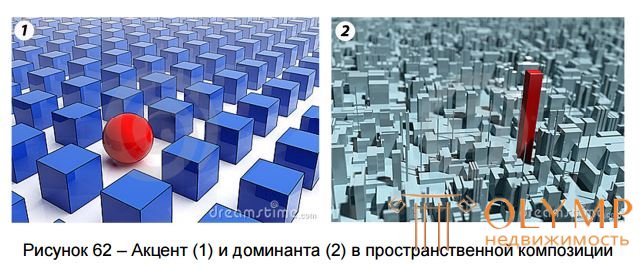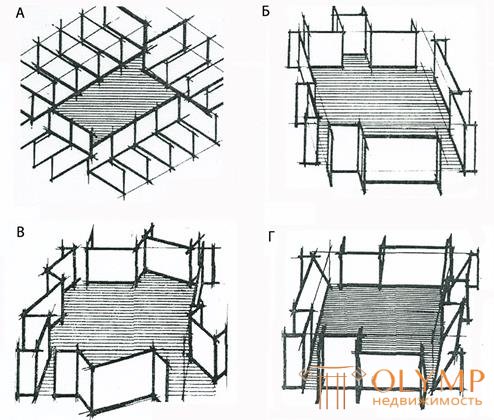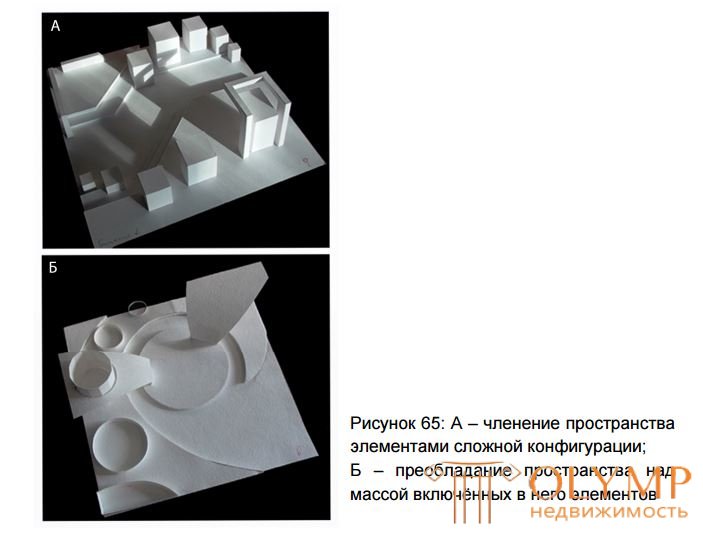
The unity and integrity of the spatial composition is based on harmony and subordination of elements. The compositional construction of a limited space is developed by the subordination of secondary elements to the main architectural volume and the main compositional element. Such an element can be a compositional center or a dominant. Between themselves, the center and the dominant can be combined and expressed by one element, expressed by various independent elements, materially not expressed or absent altogether.
Let us consider several examples characterizing the most typical arrangements of the compositional center and dominant.
Example 1: An ensemble having mutually perpendicular axes of symmetry. The dominant element of this spatial composition is the central object, which contrasts in its shape, size, mass with the surrounding structures and in its location in space. This object is located in the center, at the intersection of the main compositional axes and organizes the entire spatial composition around itself. Thus, the compositional center and compositional dominant, located in the center of space in the spatial composition, are expressed by one element.
Example 2: A space organized by several elements (primary, secondary, etc.). The configuration of the space has a complex symmetrical shape. The main compositional axis goes from the main entrance to the space to the main element and intersects at a right angle with another axis, which is the larger axis of symmetry of the oval part of the plan. The compositional dominant in this space is, of course, the main element. The ideological, semantic, artistic meaning, shape, size, position on the main compositional axis make it the main compositional element of space. In contrast to the previous example, where the dominant occupied a central position, in this case the dominant is located in depth. This arrangement of the dominant not only did not diminish its role, but on the contrary, emphasized the significance, created the dynamics in the development of the composition. At the same time, the compositional center of the space did not move along with the dominant into the depth, it remained in the middle, at the intersection of the longitudinal and transverse axes. This conditional point, being a composite node, organizes both a limited space and all compositional elements around it. Its position is fixed, fixed and expressed in architectural form. This example shows that the compositional dominant and the center can be expressed by various elements and, being on the main compositional axis, can have a different location, carry different compositional functions in space.

Figure 62 - Accent (1) and dominant (2) in the spatial composition
The location of centers and dominants in axial compositions is associated with the main directions of compositional development - the axis of symmetry or the nodal points of spatial construction: with the intersection of the axes, with a change in the direction of the main beam.
In asymmetric compositions, the location of these basic compositional elements is associated with the creation of dynamic equilibrium in space, perceived from different points.
The techniques for constructing a composition of a limited architectural space are based on the use of some property of a volume-spatial form, size, location in space of compositional elements:
→ Construction techniques that use the properties of the form and the possibility of their change are that when creating a spatial composition, the form of the element changes, the character of its shape changes, the length of the forms changes in three coordinates, resulting in volume or linear forms of the elements.
→ Using the method of changing the size of elements when constructing a composition of a limited space, one can obtain: different ratios of the coordinates of a spatial composition, symmetric, disymmetric or asymmetric construction of space, a different character of the construction of a spatial composition - static or dynamic.
Construction techniques that use the capabilities of a different position of a composite element in space include: the location of the elements bounding the space around the perimeter, the location of the surfaces of the base and the floor, the location of the composite elements that divide the space.
Receptions of an arrangement of the elements limiting space on perimeter, can form uniform front on perimeter. Elements bounding the space around the perimeter can be shifted relative to each other (Fig. 63).

Figure 63: A - scheme: the location of the elements that make up a single front; B - scheme: shifting elements; B - scheme: rotation of elements;
G - scheme: tilt elements
Space bounding elements can be rotated relative to each other. There are examples in architecture where space is limited by elements that have a slope.
Objects of architectural structures (elements) that limit space may not directly touch the plane of the base, but have intervals between the elements and the surface of the base. When the interval between the elements of the composition is turned on, the conditions for a more active connection between the confined space and the environment are created.
16.1 Techniques for positioning the base surface
When constructing a composition of the architectural space, it is possible to use the reception of the location of the surfaces of the base and the floor (in the interiors). The most common is the horizontal position of the base surface. The horizontal position of the base surface in an organized space is primarily associated with the convenience of the action and movement of a person in it (Fig. 64 A).
Among the works of architecture there are examples with a more complex surface base, in particular the base, located on several levels.

Figure 64: A - scheme: the interval between the elements and the surface of the base; B - scheme: dissected space
With the location of elements in space and their shape is related its relative integrity or dismemberment.
The architectural space can be unified (undifferentiated) and perceived by the viewer entirely. Most often this is a composition of a simple geometric shape of the plan and a simple form of limiting elements.
The bounding architectural space can be dismembered if its plan or section has a complex configuration, i.e. due to the position in space of the limiting elements (Fig. 64 B).
Dismemberment of space can be achieved by using elements of a complex configuration. With such a construction, the space enclosed within the elements themselves becomes an integral part of the general organized space that these elements limit.
The limited architectural space can be dissected by elements located inside it. When introducing dividing elements into a spatial composition, an interrelation and interdependence of the limited space and mass of elements introduced into it arise.
Examples from the practice of architecture show that the ratio of the mass of the introduced elements and the limited space lies within the limits when: space prevails over the mass of its dividing elements; the mass of dividing (introduced) elements prevails over space.
Consequently, the dismemberment of space depends on the location and shape of the elements and on the presence of dividing elements.
Using the techniques of constructing a spatial composition in which changes in the shape and size of elements are inextricably linked with their location in space, you can build a space of symmetric or asymmetric shape, with different coordinate ratios and degree of closure, create basic guidelines for compositional development using a certain arrangement of dominants, other elements, to build a holistic or dismembered space, obtaining together with it certain plastic solutions (Fig. 65).

Figure 65: A - division of space by elements of a complex configuration; B - the predominance of space over the mass of the elements included in it
Что бы оставить комментарий войдите
Комментарии (0)